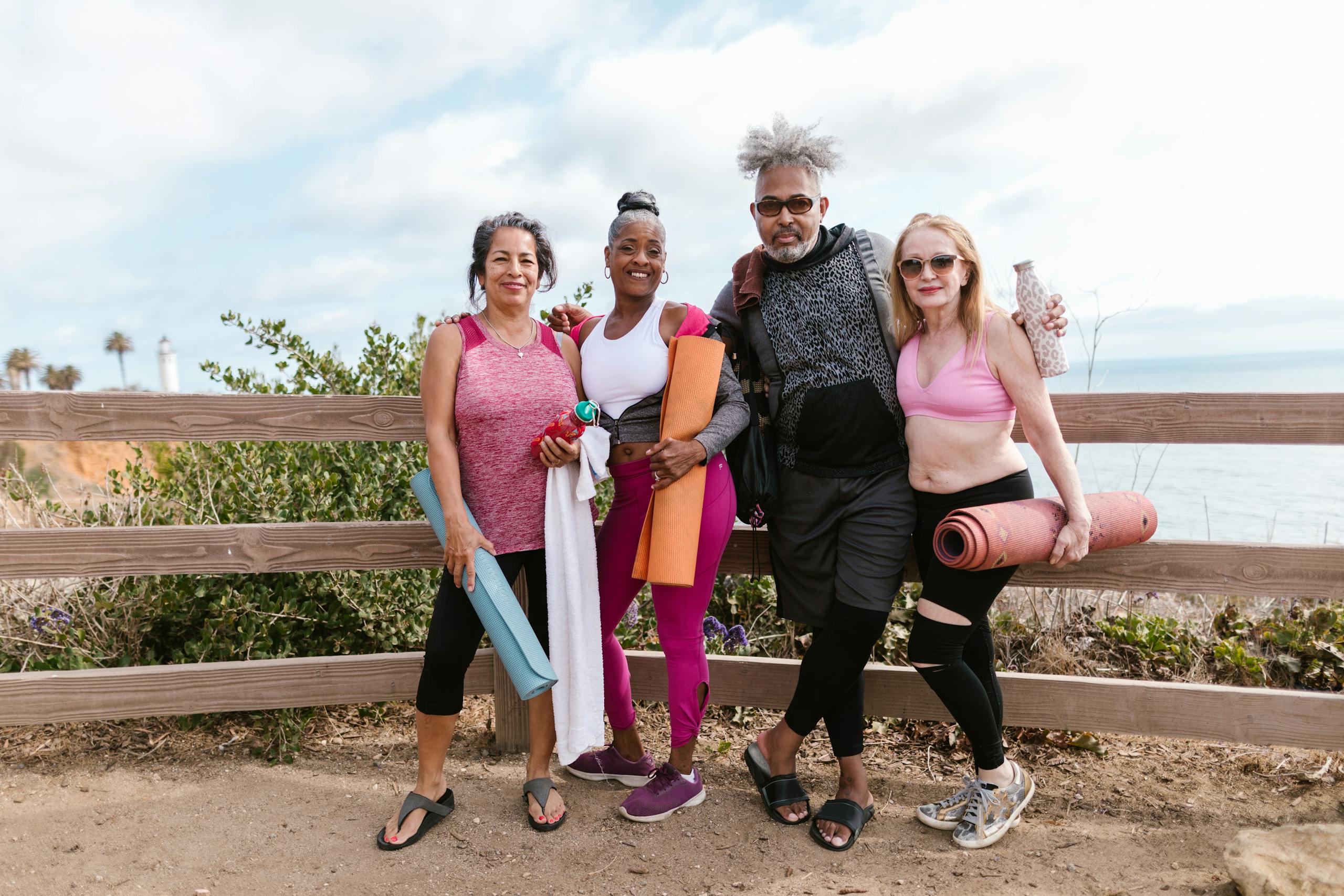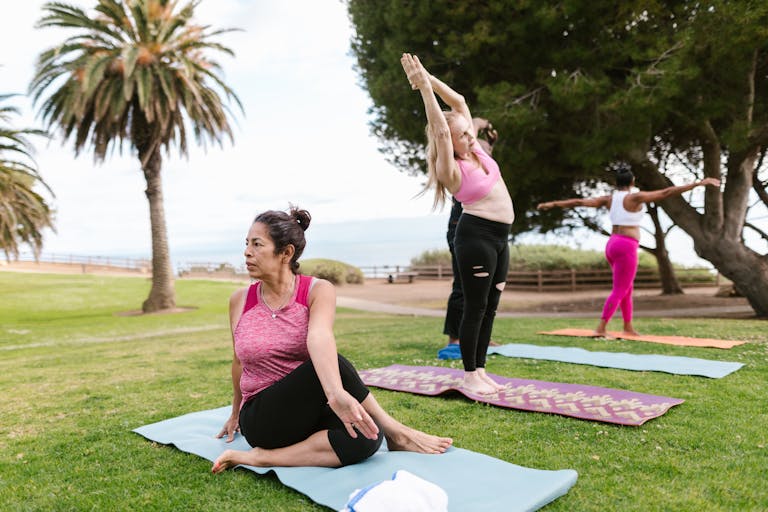How Often Should Seniors Exercise?
How often should seniors exercise? That’s a question many of us ask, whether it’s for ourselves, our loved ones, or even just to be prepared for the future.
Staying active as we age is about adding life to our years! Imagine waking up every morning feeling strong, energized, and ready to take on the day.
And for seniors, it’s the secret and key to maintaining independence, reclaiming vitality, reducing the risk of chronic diseases, boosting mental clarity and staying healthy well into your golden years while feeling younger at heart!
So in this post, we’re breaking it all down—how often seniors should exercise, the best types of workouts, what does a ideal weekly workout plan look like for those 60 and older and why it’s never too late to start.
We’ll also explore an ideal exercise routine that promotes strength breaking it down into simple, actionable steps.
So whether you’re looking to improve mobility, reduce the risk of chronic diseases, or just stay active and independent, this post will show you how to make exercise a regular and rewarding part of life. Let’s dive in
Why Exercise is Crucial for Seniors
As we age, our bodies naturally go through changes. Muscles tend to weaken, bones become less dense, and balance can start to waver. The good news? Regular exercise can counteract many of these changes!
Here are some of the incredible benefits of staying active:
- Improved Strength and Balance: Regular strength training can reduce the risk of falls by up to 30%.
- Enhance Cardiovascular (Heart) Health: Cardio workouts improve circulation, lower blood pressure, and keep your heart strong. Lowering the risk of heart disease and stroke.
- Joint Flexibility: Gentle stretching and movement reduce stiffness and keep you limber.
- Better Mental Health: Exercise boosts endorphins, helping to reduce stress, anxiety, and even symptoms of depression.
- Chronic Disease Management: Regular physical activity can help manage diabetes, arthritis, and even osteoporosis.
- Boost Mobility: Helps reduce the risk of falls—one of the leading causes of injury among seniors.
- Strengthen muscles and bones: Helps to combat osteoporosis and age-related muscle loss (sarcopenia).
- Maintain Cognitive function: Help to keep the mind sharp and reduce the risk of dementia.
Now that we know why exercise is so important, let’s answer the next big question: How often should you be working out?
How Often Should Seniors Exercise?
An Ideal Weekly Workout Plan for Seniors (60+)
According to health experts, seniors should aim for the following weekly exercise routine: Experts recommend a balanced approach to fitness that includes a mix of aerobic exercise, strength training, flexibility, and balance exercises. Let’s take an in-depth look at each component and why it matters.
1. Aerobic Exercise: 30 Minutes 3- 5 Days Per Week
Cardio workouts are essential for maintaining heart and lung health. For seniors, aerobic exercise doesn’t need to be intense to be effective. Here are some excellent options and why they’re beneficial:
What It Is?: Aerobic exercises, also known as cardio, include activities that get your heart rate up and keep it elevated for a sustained period. These could be brisk walking, swimming, dancing, or cycling.
How Often?: Seniors should aim for at least 30 minutes of moderate-intensity aerobic activity 5 days a week. Or break it into shorter 10–15 minute sessions throughout the day.
Benefits of Aerobic Exercise:
- Heart and Lung Health: Regular aerobic activity strengthens the heart and lungs, improving their efficiency and lowering blood pressure.
- Weight Management: Cardio helps seniors maintain a healthy weight by burning calories.
- Energy Levels: Aerobic exercise improves stamina, making daily tasks easier and less tiring.
- Mental Health Benefits: Activities like walking outdoors also release endorphins, lifting mood and combating depression.
Types of Aerobic Exercises
1. Walking: Walking is one of the simplest and most accessible forms of exercise. It’s easy on the joints and allows you to adjust the pace to your fitness level. Regular walking improves circulation, lowers blood pressure, and helps maintain a healthy weight. A brisk 30-minute walk three to five times a week can work wonders for your cardiovascular health.
2. Swimming: This low-impact activity engages multiple muscle groups while being gentle on your joints. Swimming improves endurance, flexibility, and strength, making it an ideal choice for individuals with arthritis or joint pain.
3. Cycling: Whether on a stationary bike or outdoors, cycling offers an excellent cardio workout that’s gentle on the knees. It’s also a great way to build leg strength and improve balance.
If you’re new to aerobic exercise, start slow. Even 10-15 minutes of activity can make a difference, and you can gradually build up to 30 minutes as your stamina improves.
Also for those with joint issues, low-impact options like swimming or using a stationary bike are excellent alternatives.
2. Strength Training: 2-3 Days Per Week
Building and maintaining muscle mass is vital as you age. Strength training not only improves your physical strength but also helps with bone density, which reduces the risk of osteoporosis and fractures. Here’s a closer look at what you can do:
What It Is?: Strength training involves resistance exercises that target muscles. These can include lifting light weights, using resistance bands, or bodyweight exercises like squats, wall push-ups, or leg lifts.
How Often?: 2 to 3 sessions per week with at least one rest day between sessions to allow for muscle recovery.
Benefits of Strength Training:
- Muscle Preservation: Seniors naturally lose muscle mass with age. Strength training helps combat this decline, keeping muscles strong and functional.
- Bone Health: Resistance exercises stimulate bone growth and density, reducing the risk of osteoporosis and fractures.
- Daily Functionality: Strong muscles make everyday activities—like climbing stairs, carrying groceries, or getting out of a chair—easier and safer.
- Fall Prevention: Improved strength enhances balance, which can drastically reduce fall risks.
For beginners, starting with light resistance and focusing on proper form is crucial. Consulting a trainer or physical therapist can ensure exercises are safe and effective.
Types of Strength Training:
1. Bodyweight Exercises: Simple movements like squats, wall push-ups, and chair stands are highly effective. These exercises use your own body weight to build strength and are a great starting point for beginners.
2. Resistance Bands: Resistance bands are affordable, portable, and versatile. They provide gentle resistance that’s perfect for seniors who want to build strength without heavy weights. For example, you can use them for bicep curls, shoulder presses, and leg lifts.
3. Free Weights: Light dumbbells can be incorporated into your routine for added resistance. Focus on controlled movements and proper form to prevent injury. Aim for exercises that target major muscle groups, such as arms, legs, and core.
Perform 8-12 repetitions of each exercise and gradually work your way up to 2-3 sets. Remember, it’s about progress, not perfection, so start with weights or resistance levels that feel manageable.
3. Flexibility and Stretching Exercises: 3-4 Days Per Week
Flexibility is often overlooked, but it’s a critical component of a balanced fitness routine. Stretching helps reduce stiffness, improve range of motion, and alleviate tension. Here’s how to make it a regular part of your week:
What It Is?: These exercises focus on coordination, flexibility, and joint mobility. Examples include Tai chi, Pilates, and simple stretches.
How Often?: At least 3 to 4 days per week, with sessions lasting 10–15 minutes a day, or incorporate into daily activities
Benefits of Flexibility and Stretching Exercises:
- Fall Prevention: Engaging in flexibility and stretching exercises helps train and stabilize muscles as well as improves coordination, significantly reducing the likelihood of falls.
- Joint Mobility: Stretching increases the range of motion in joints, helping with stiffness and pain.
- Relaxation: Activities like Pilates and tai chi also incorporate breathing techniques, promoting relaxation and reducing stress.
- Better Posture: Flexibility exercises help improve posture, reducing strain on the spine and muscles.
Types of Flexibility and Stretching Exercises:
1. Gentle Stretches: Incorporate simple movements like side bends, neck rolls, and toe touches into your daily routine. These stretches can be done anytime and don’t require any special equipment.
2. Pilates: Pilates, especially chair Pilates or senior-friendly classes, combines stretching with mindfulness. It’s an excellent way to enhance flexibility, reduce stress, and improve posture.
Consistency is key with stretching, so aim to spend at least 5-10 minutes on it a few times a week. Over time, you’ll notice improved mobility and reduced aches and pains.
4. Balance Exercises: 2-3 Days Per Week
Falls are one of the leading causes of injury in seniors, making balance exercises a critical part of any fitness routine.
Balance exercises focus on strengthening stabilizing muscles, improving coordination, and enhancing spatial awareness. They help reduce the risk of falls, maintain independence, and improve confidence in daily movements.
Here’s a breakdown of balance exercises, how often to perform them, and their benefits:
What It Is? Balance exercises are designed to challenge your body’s stability and control. They work on the muscles in your legs, core, and feet, as well as your nervous system’s ability to respond to changes in your body’s position.
These exercises are especially beneficial for seniors as they mimic everyday movements, such as standing, walking, and reaching, making them highly practical.
How Often? Experts recommend incorporating balance exercises into your routine 2-3 days per week.
Each session can last 15-20 minutes and can be done on its own or as part of a broader workout. Start with simple movements and gradually increase complexity as your balance improves.
Benefits of Balance Exercises:
- Reduced Risk of Falls: By improving stability and coordination, balance exercises significantly decrease the likelihood of falls, which are a major cause of injury in older adults.
- Enhanced Mobility: Improved balance translates to better movement and ease in performing daily tasks such as climbing stairs, reaching for objects, or walking on uneven surfaces.
- Increased Confidence: With better balance, seniors often feel more confident and secure in their movements, promoting a sense of independence.
- Improved Posture: Balance exercises engage core muscles, leading to better posture and alignment.
- Overall Quality of Life: With reduced injury risk and improved functional abilities, balance exercises contribute to a higher quality of life.
Types Balance Exercises:
1. Standing on One Foot: This is a foundational balance exercise. Stand near a sturdy chair or wall for support, and lift one foot off the ground.
Hold this position for 10-15 seconds, then switch to the other foot. Over time, challenge yourself by increasing the duration or removing the support.
2. Heel-to-Toe Walking: Walk in a straight line by placing one foot directly in front of the other, heel to toe. Keep your arms out for balance or use a wall for support. This exercise improves balance, coordination, spatial awareness, and stability.
3. Tai Chi: This ancient practice is often referred to as “meditation in motion,” Tai Chi is a low-impact exercise that combines slow, flowing movements with deep breathing.
It’s highly effective for improving balance, flexibility, and mental focus. Studies have shown that seniors who practice Tai Chi regularly experience a significant reduction in fall risk.
4. Side Leg Lifts: Stand behind a chair and lift one leg to the side without tilting your torso. Lower it back down and repeat 10-15 times on each side.
This exercise strengthens the hip stabilizers, which play a key role in maintaining balance.
5. Weight Shifts: Stand with your feet shoulder-width apart and slowly shift your weight onto one leg, lifting the opposite foot slightly off the ground. Hold for a few seconds, then switch sides.
This exercise helps improve control and stability in the lower body.
Incorporate these exercises into your routine for better stability and reduced risk of falls. Even small improvements in balance can make a big difference in daily life.
5. Rest and Recovery: 1-2 Days Per Week
Recovery is just as important as the workouts themselves. Giving your body time to rest prevents overtraining and reduces the risk of injury.
Here’s what a good recovery day might look like:
Why It’s Important: Recovery days are just as essential as workout days. Allow the body to heal and adapt, especially if new to exercising.
What It Is: Rest and recovery refer to allowing the body time to heal and adapt after exercise. This doesn’t mean complete inactivity but rather light activities like walking or stretching.
How Often: Active recovery can be incorporated into daily life, but seniors should aim for at least one or two full rest days per week.
Benefits of Rest and Recovery:
- Injury Prevention: Overexertion can lead to strains, sprains, or fatigue.
- Muscle Repair: Strength training, in particular, creates small tears in muscle fibers that need time to heal and grow stronger.
- Energy Restoration: Recovery allows the body to replenish energy stores, ensuring consistent performance over time.
Some Examples of Things You Can Do:
Light Activities: Engage in low-intensity activities like leisurely walks, gardening, or stretching. These activities keep your body moving without putting stress on your muscles or joints.
Relaxation: Take time to relax and recharge. Consider activities like reading, meditating, or even taking a warm bath to soothe tired muscles.
Remember, rest days are an essential part of any fitness routine. They give your body the time it needs to repair and rebuild, so you can stay consistent and avoid burnout.
Tips to Get Started with an Exercise Routine
- Start Slow and Build Up: If you’re new to exercise, begin with shorter, less intense sessions (10–15 minutes) and gradually increase duration and intensity as your endurance and confidence grow.
- Focus on Enjoyable Activities: Whether it’s gardening, dancing, or joining a group fitness class, pick activities that you enjoy to keep you motivated.
- Listen to Your Body: Pay attention to any signs of discomfort or fatigue. If something doesn’t feel right, adjust, modify the exercise to suit your needs or stop the activity.
- Stay Consistent: Consistency is more important than intensity. Even small daily efforts add up over time. Create a weekly schedule and stick to it. Consistency is key to long-term benefits.
- Seek Professional Guidance: Working with a personal trainer or joining a senior-focused fitness program can ensure exercises are both safe and effective.
Tips for Staying Motivated
- Find a Workout Buddy: Exercising with a friend can make it more enjoyable and keep you accountable.
- Set Realistic Goals: Start with small, achievable milestones and celebrate your progress.
- Listen to Your Body: If something feels uncomfortable or painful, stop and adjust your routine.
- Try New Activities: Experiment with different types of exercise to keep things exciting—from water aerobics to dance classes.
The Role of Nutrition in Supporting Exercise
Exercise alone isn’t enough—nutrition plays a critical role in supporting an active lifestyle. Seniors should focus on:
- Protein: To rebuild and strengthen muscles. Incorporate lean meats, eggs, legumes, or plant-based protein sources.
- Hydration: Drink plenty of water before, during, and after exercise to stay energized and prevent dehydration.
- Calcium and Vitamin D: Essential for bone health; include dairy, leafy greens, or fortified foods.
- Healthy Carbs: Provide energy for workouts. Opt for whole grains, fruits, and vegetables.
Pairing regular exercise with a balanced diet creates a powerful combination for overall wellness.
Also remember it’s always a good idea to check in with your healthcare provider, especially if you have pre-existing conditions or haven’t been active in a while.
They can help you tailor a plan that’s safe and effective for your specific needs.
Final Thoughts
Exercise is one of the best gifts you can give yourself at any age, but especially after 60. Exercise is the foundation for healthy aging, helping seniors maintain independence, vitality, and a sense of well-being.
By committing to a balanced weekly workout plan, incorporating regular aerobic activity, strength training, balance, and flexibility exercises into your weekly routine, you can enhance the quality of life significantly.
You’ll not only feel stronger and healthier but also enjoy a renewed sense of confidence and vitality.
So, how often should seniors exercise? The answer lies in finding the right balance that works for you—just remember, it’s never too late to start.
Every step, every stretch, and every movement counts toward a healthier, more vibrant you. Here’s to a stronger, healthier, and happier you!







